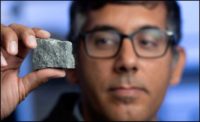Among the most surprising findings of the recent offshore drilling was the fast rate at which gas hydrate is forming. When hydrate forms rapidly, the salts in the surrounding seafloor sediments do not have time to diffuse and the water in the sediment becomes saltier than seawater. Scientist Marta Torres of Oregon State University explained, "We observed high concentrations of sea salts in the upper 10-15 meters of sediment, indicating that hydrate is forming very rapidly below the seafloor in this region."
Ocean drilling plays a critical role in addressing questions about hydrates because it provides the only means available of directly sampling the material and the sediments that host them deep beneath the seafloor. In 1995, ODP researchers drilled into gas hydrates in a relatively stable area off the U.S. East Coast.
Scientists have estimated that area could contain enough methane to supply U.S. energy needs for more than 100 years. They also found evidence suggesting that hydrates are involved in the global climate cycle, and that they can cause massive landslides. On the recent cruise, scientists also gained an understanding of the importance of sediment composition and grain size in the distribution of hydrates within the sediments, which may provide clues to their locations.



